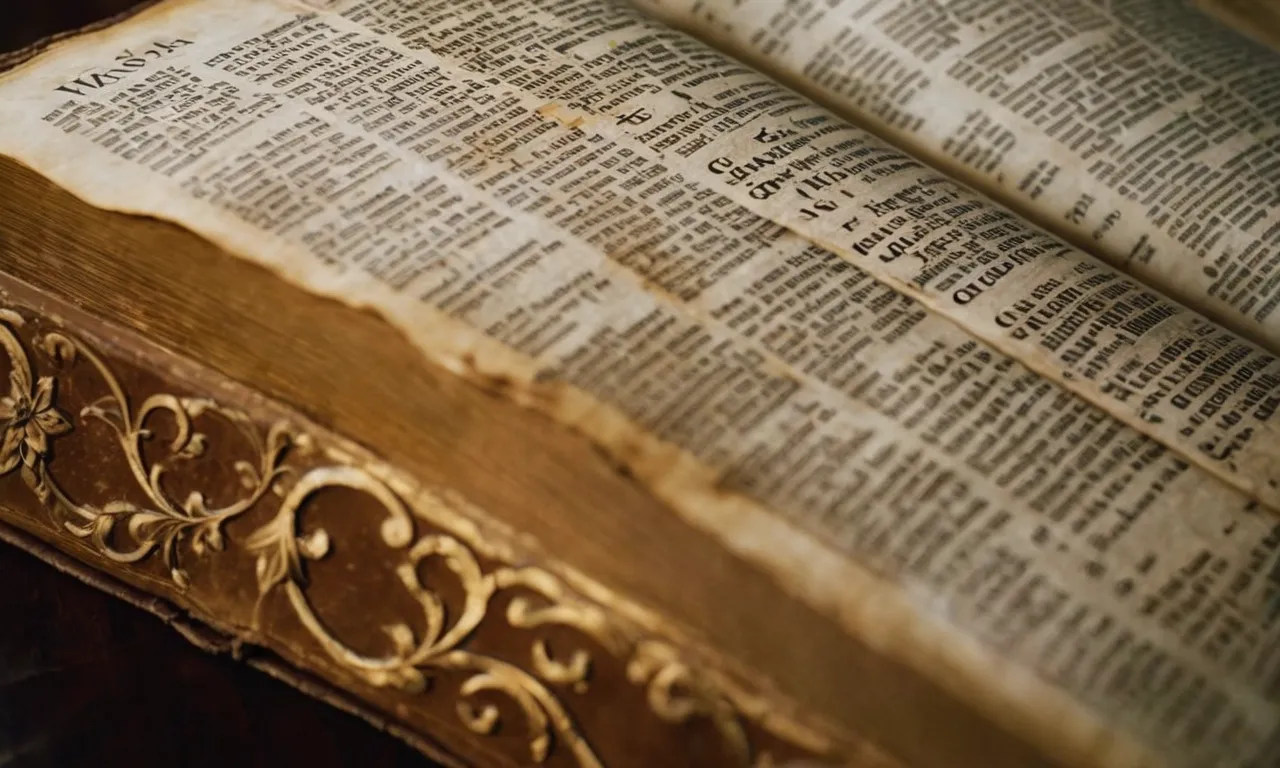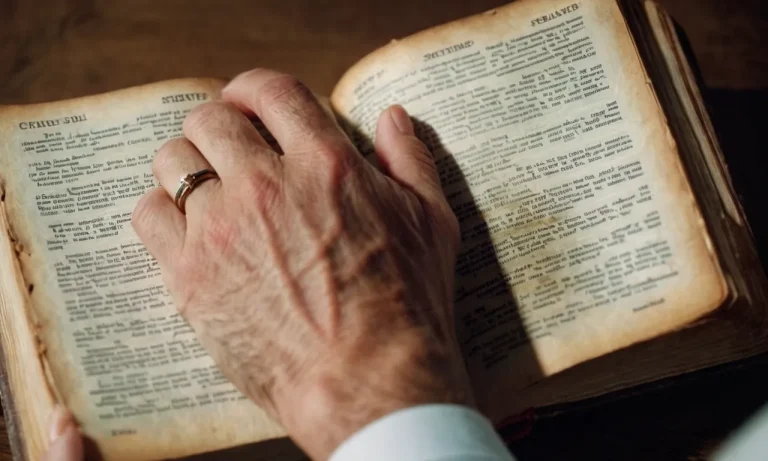Why Was The Book Of Eli Removed From The Bible?
The Book of Eli is not actually a real biblical text. It’s the name of a 2010 American post-apocalyptic action film starring Denzel Washington as a lone wanderer carrying the last remaining copy of a mysterious sacred text across a ravaged landscape.
However, the film does raise interesting questions about how the biblical canon was formed.
If you’re short on time, the key points are: The biblical canon refers to the books considered authoritative and divinely inspired. The Book of Eli doesn’t exist – it’s a movie, not an actual book of the Bible.
There were many texts considered for inclusion but ultimately left out of the biblical canon. The Councils of Carthage and Hippo in the late 4th century largely settled on the 27 New Testament books we have today.
The Formation of the Biblical Canon
What Is the Biblical Canon?
The Biblical canon refers to the set of texts considered to be authoritative Scripture and part of the Bible by various religious traditions. It derives from the Greek word kanon, meaning “rule” or “measuring stick.”
The canon established which books were divinely inspired and should be included in the Bible.
The formation of the Biblical canon was a gradual process that took place over several centuries, involving debate, research, and councils of rabbinical and Christian scholars. Several criteria were used to determine whether a text should be considered canonical, including: antiquity, orthodoxy of doctrine, authorship, and widespread use and acceptance by faith communities.
Early Christian Texts and Influence
In the first few centuries CE, in addition to the books that now comprise the New Testament, early Christians read and circulated various other texts. These included the Didache, 1 Clement, the Shepherd of Hermas, the Epistle of Barnabas, and the Apocalypse of Peter.
While some early Christian leaders quoted these texts, most recognized a distinction between writings they considered scriptural and those that had questionable origins or doctrines. Still, it took time for consensus to emerge on the scope of the Biblical canon.
Some later-rejected books even met some key criteria, like the Apocalypse of Peter, which was considered scriptural by some due to its (false) claim to Petrine authorship.
Key Councils and Decisions
Several church councils played pivotal roles in deciding the Biblical canon in Christianity. The Council of Rome (382 CE) and the Council of Hippo (393 CE) laid down the first formal lists of canonical texts, including the full 27-book New Testament canon recognizable today.
The most significant canonization council was at Carthage (397 CE). Augustine and the participating bishops fixed the entire New Testament canon and Old Testament books, establishing the authority that would become universally accepted in Western Christianity (and later Protestantism) to the present day.
Their decision provided the Catholic/universal church with its first definitive canon.
So in the end, the Book of Eli was likely never considered part of the developing Biblical canon. While some early Christian texts like the Shepherd of Hermas or Epistle of Barnabas were debated, the Book of Eli doesn’t seem to have been known or circulated enough to have ever been considered scriptural, even briefly, before being excluded from the final Catholic canon.
Apocryphal and Deuterocanonical Texts
Definition and Examples
Apocryphal texts refer to writings that are not considered part of the biblical canon. The word “apocrypha” comes from the Greek word meaning “things hidden away.” These texts were written in the same time period as the books that were included in the Hebrew Bible, but were not seen as scripture by the Jewish communities.
Some key apocryphal writings include:
- The Book of Enoch
- The Book of Jubilees
- The Gospel of Thomas
- The Gospel of Mary Magdalene
- The Apocalypse of Peter
Deuterocanonical books refer to writings that were included in some versions of the Old Testament canon used by early Christians, but were not part of the Hebrew Bible. “Deuterocanonical” means “part of a secondary canon.”
Examples of deuterocanonical texts include:
- Tobit
- Judith
- The Wisdom of Solomon
- Sirach
- Baruch
- 1 and 2 Maccabees
Reasons for Exclusion from the Canon
There are several reasons why certain texts written in the same historical period were excluded from the biblical canon accepted by mainstream Judaism and most forms of Christianity:
- Questions about authentic authorship – For example, most scholars believe the Gospel of Thomas was written too late to have been written by the apostle Thomas.
- Contradictions or inconsistencies with other accepted scriptures
- Not in widespread use among early Jewish and Christian communities
- Controversial teachings or doctrines that were rejected by religious authorities
For example, the Dead Sea Scrolls showed that the deuterocanonical Book of Tobit was not widely used among many Jewish groups. And the Gospel of Thomas has sayings attributed to Jesus that contradict the canonical gospels.
Additionally, Martin Luther argued strongly against the deuterocanonical books and excluded them from his translation of the Bible into German during the Reformation. This cemented their status as “apocrypha” rather than scripture for Protestants.
Uncertainty Around Some New Testament Texts
Debates Over Books Like James and Revelation
In the early centuries of Christianity, there were debates among church leaders over the canonicity of some New Testament books, like James, Jude, 2 Peter, 2 and 3 John, Hebrews, and Revelation. Books like James emphasized works more than Paul’s teachings on salvation by faith alone, causing some to question their authority.
Revelation’s imagery and symbolism also made its status uncertain.
The early church father Eusebius recorded the various debates over these books in the 4th century AD. For example, he wrote that James was disputed by some, Jude was rejected by many, and Revelation was still disputed by some in his day.
So there was not an initial consensus on the canonicity of all 27 books we have today.
Eventual Agreement on the 27 Book New Testament
While debates continued for centuries, the 27 books we have today were identified by Athanasius in 367 AD in his annual Easter letter. This list was later confirmed as authoritative at church councils like Hippo Regius in 393 and Carthage in 397.
So by the late 4th century, there was general agreement on the canon of scripture we have today.
Some key reasons these books were eventually accepted into the canon were their apostolic origins or endorsement, their widespread early use and citation by early church fathers, and their consistency with other accepted scriptures.
The early church realized they needed a defined body of authoritative scriptures to guide their theology and practice as Christianity spread across the Roman Empire and beyond.
Conclusion
While the Book of Eli itself is fictional, the complex debates behind forming the biblical canon were very real. Many writings floated around the early Christian world, but church councils ultimately made decisions about what was considered inspired scripture.
This left various apocryphal and deuterocanonical books by the wayside, dismissed for theological and traditional reasons. While largely settled since the 4th century, there remains occasional disagreement around the canonicity of a few New Testament works to this day.







